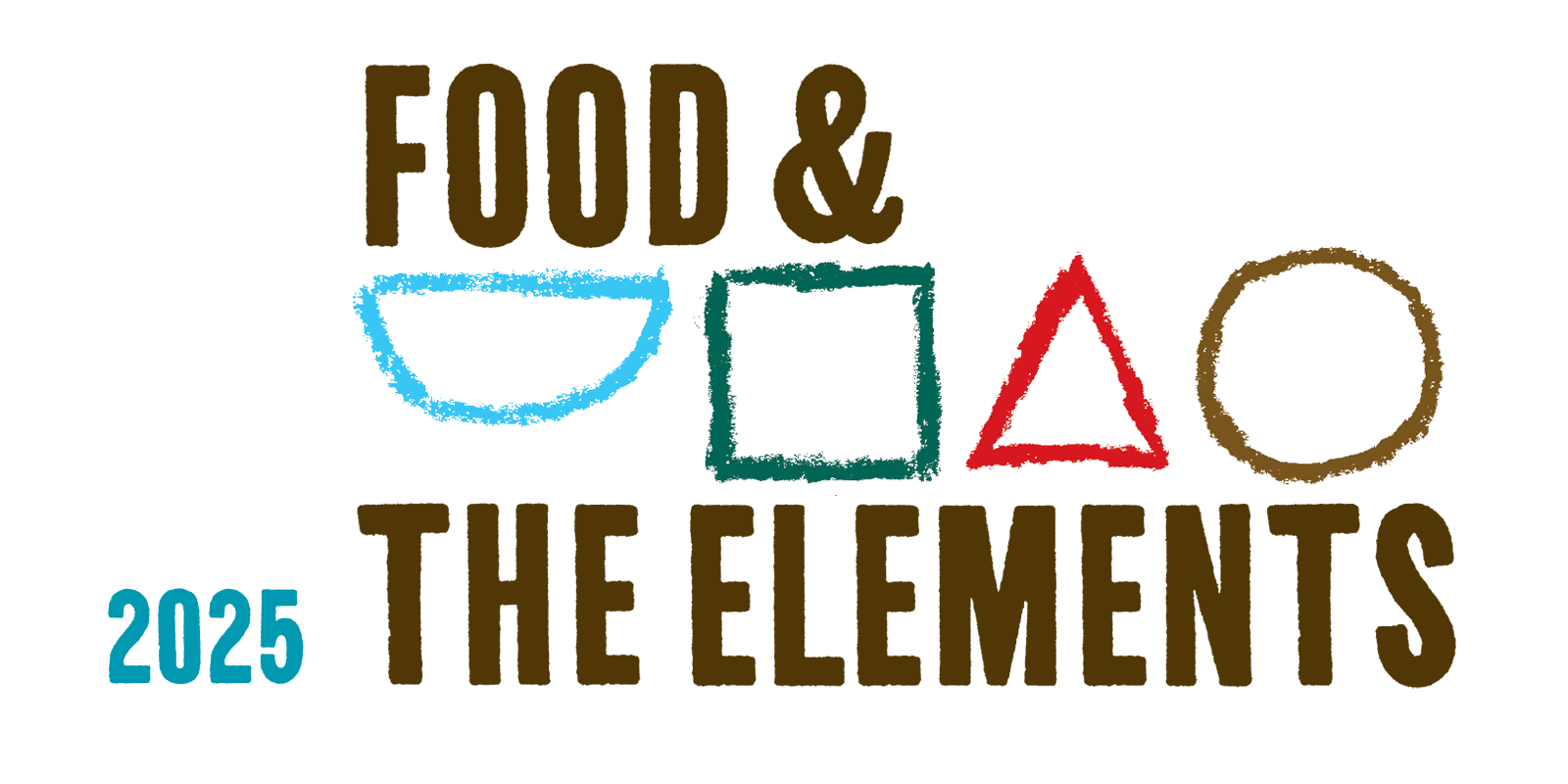
and Online (dates tbc)

When we think of ‘The Elements,’ our 2025 theme, our minds race with possibilities. ‘Elements’ boasts myriad meanings, whether in the context of science, the physical senses, weather, culinary epistemologies, and cooking techniques and technologies. What all of these avenues of entry into the theme of ‘The Elements’ share is the characteristic of being fundamental: in other words, proposals should demonstrate a tight nexus between ‘The Elements’ and food and cookery.
‘The Elements’ immediately conjures visions of the periodic table. The elements identified there combine to create the many molecules and compounds of the physical world, and we encourage proposals that consider their culinary functions. Two of the simplest molecules are salt and water, both essential to life and to food and cookery. To use salt as an example, proposers might probe its impact on taste perceptions, its role as a preservative, its history as an essential commodity, its application in unusual cookery techniques, or its appearance as a metaphor or cultural symbol.
Taste perceptions might raise matters of neurogastronomy, connoisseurship, and terroir, while preservation might look to activities within the kitchen and beyond. Salt has historically been a source of power and wealth for those who control the supply, often with geopolitical consequences. Other approaches might investigate specific culinary techniques: salt crusts encase fish and meats with succulent results, while ‘salt-rising bread’ is a distinctive Appalachian specialty. Cultural uses of salt might be explored, whether in literary, folkloric, or religious contexts.
Salt is only one of many examples of an elementary molecule that shapes foodways. Culinary systems also make wide use of acids, sugars, and alcohols for flavor and preservation and as the basis of traditional and homemade remedies. Like salt, these food molecules have literary, cultural, political, and economic expressions. They also have physical consequences for the body and the environment. Water, too, is elemental, whether as an ingredient, cooking medium, or part of culinary epistemologies, and access to water has been a critical matter throughout history and is of especial concern for agriculture in contemporary food systems. Elements such as calcium, magnesium, phosphorus, potassium and sodium similarly are essential nutrients in the soil that nourish the plants that nourish us. Proposers will undoubtedly find intriguing ways of examining these fundamental elements and molecules.
Less traditional molecules have found places in contemporary foodways. Modernist cuisine’s reliance on nontraditional culinary molecules has opened a vista of gastronomic innovation for practitioners and diners alike. Complex molecules dominate the ingredients lists of highly and ultra processed foods, sparking scientific and cultural debates over their definition, their impact on human health, and their role in providing accessible, affordable, and long-lasting foods. These relatively new additions to the food processing larder might prove fertile ground for exploration, as might the mid-twentieth century dogma of ‘better living through chemistry’ with its consequences for agriculture, the environment, and the home kitchen.
Moving beyond a focus on science, we note that food and cookery depend on material culture, that is, on a society’s physical objects that make manifest its belief systems. Air, earth, fire, water, wood, and metal all have been categorized as ‘elements’ in different cultures and at different points in history, as have the qualitative binaries of hot-cold and wet-dry. Proposers might follow a literal approach to these elements and qualities, considering air-drying and dehydrating, roasting and baking, and the many varieties of wet heat cookery. Another approach might investigate the equipment used for these techniques, whether made from clays, wood, metals, or even the simplest adaptations of the earth for barbacoa, bog butter, or other buried dishes. The creation of ‘cold,’ whether mechanical, chemical, or through ice harvesting, could be another fruitful approach.
These elements and qualities become metonyms in the grammar of Ayurvedic, humoral, iatrochemical, and traditional Chinese medicine, suggesting other ways in which symposiasts might investigate the role of ‘elements’ in culinary and dietetic practices. Venturing further into more theoretical constructs, proposers might explore the elements of culinary systems: Mary Douglas famously formulated the mid-twentieth century middle-class English dinner as A+2b, requiring a centering animal protein supported by two side dishes. Other systems and cultures require different combinations and separations of foodstuffs and dishes with different relative importance to create a ‘real’ meal. Other structural approaches might examine the temporal ordering of dishes or the assemblage of different cooking techniques that are thought needed for culturally determined ‘proper’ meals. The segregation of sweet from savory foods, the repetition or inclusion of key ingredients or foodstuffs, or the elimination of tabooed foods might also reveal the elements that comprise meal structures.
A final aspect of ‘The Elements’ looks to the immense topic of weather. While meteorologists debate the number of ‘elements’ that form weather patterns, all include temperature, humidity, precipitation, wind, and sunlight as part of the weather calculus. Significant changes in weather patterns, aka climate change, influence food production and distribution, as seen in the North Atlantic’s Little Ice Age or our current global period of unprecedented warming and extreme weather. These shifts challenge food security, requiring changes in crops and agricultural techniques with profound implications for food and cookery. Questions of environmental justice, technological innovation, and cultural adaptations as they related directly to food and cookery could all be valuable contributions to our discussions of ‘The Elements.’
Whether proposers elect to investigate ‘The Elements’ through the portals of science and molecules (including the history, culture, politics, and economics attached to these essential culinary building blocks); culinary, dietetic, or medicinal epistemologies; techniques and technologies, or weather and the environment, we anticipate a rich variety of proposals that will contribute to a deeply rewarding exploration of ‘The Elements’ of food and cookery.
We invite paper proposals on the topic of “Food & the Elements” from the 1st October, with a submission deadline of the 31st December.
